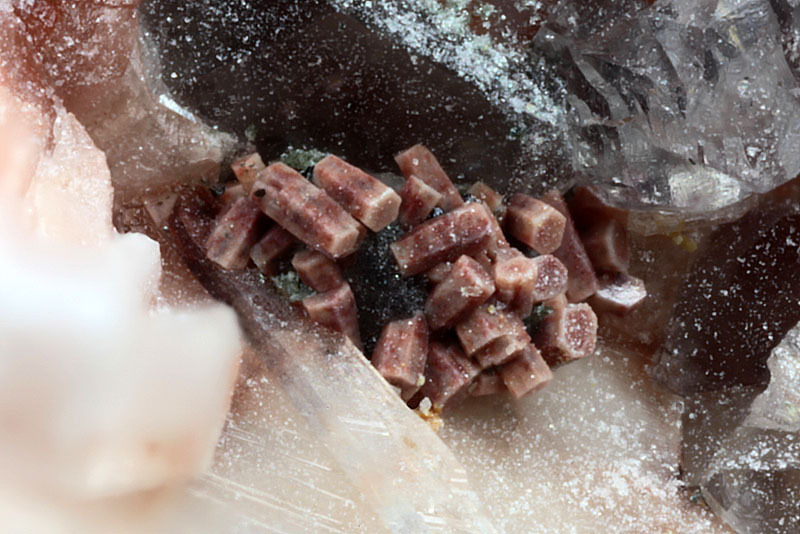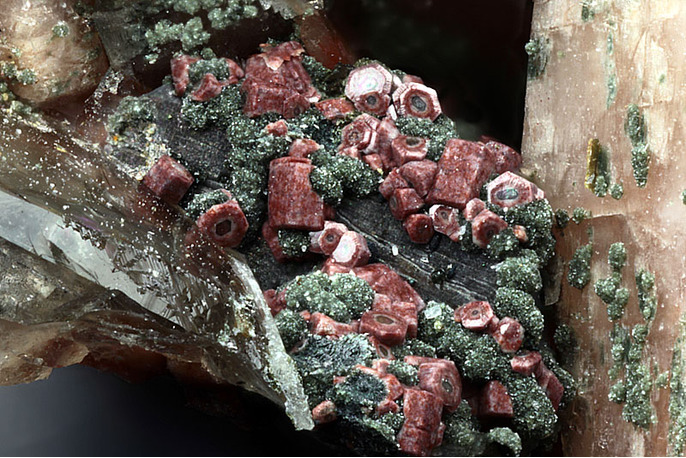Synchysite-(Y) (original) (raw)
A valid IMA mineral species - grandfathered
About Synchysite-(Y)Hide
This section is currently hidden. Click the show button to view.
Colour:
White, reddish brown, greyish yellow, dull yellow; colourless to light yellow in transmitted light
Lustre:
Sub-Adamantine, Vitreous, Greasy
Crystal System:
Monoclinic
Name:
From the Greek σύγχΰσις "synchys" for "confounding" in allusion to its initially being mistaken for parisite, and the "-(Y)" suffix due to the dominance of yttrium in the composition.
Unique IdentifiersHide
This section is currently hidden. Click the show button to view.
Long-form identifier:
mindat:1:1:3855:9
30fea8ff-4470-40d2-9435-e8e9035b3a4f
IMA Classification of Synchysite-(Y)Hide
This section is currently hidden. Click the show button to view.
Approved, 'Grandfathered' (first described prior to 1959)
IMA status notes:
Renamed by the IMA
Classification of Synchysite-(Y)Hide
This section is currently hidden. Click the show button to view.
5.BD.20c
5 : CARBONATES (NITRATES)
B : Carbonates with additional anions, without H2O
D : With rare earth elements (REE)
16a.1.3.2
16a : ANHYDROUS CARBONATES CONTAINING HYDROXYL OR HALOGEN
1 : (AB)(XO3)Zq
12.1.14
12 : Carbonates with other anions
1 : Carbonates with halides
Mineral SymbolsHide
This section is currently hidden. Click the show button to view.
As of 2021 there are now IMA–CNMNC approved mineral symbols (abbreviations) for each mineral species, useful for tables and diagrams.
Please only use the official IMA–CNMNC symbol. Older variants are listed for historical use only.
| Symbol | Source | Reference |
|---|---|---|
| Syn-Y | IMA–CNMNC | Warr, L.N. (2021). IMA–CNMNC approved mineral symbols. Mineralogical Magazine, 85(3), 291-320. doi:10.1180/mgm.2021.43 |
| Syn | The Canadian Mineralogist (2019) | The Canadian Mineralogist (2019) The Canadian Mineralogist list of symbols for rock- and ore-forming minerals (December 30, 2019). download |
Physical Properties of Synchysite-(Y)Hide
This section is currently hidden. Click the show button to view.
Sub-Adamantine, Vitreous, Greasy
Colour:
White, reddish brown, greyish yellow, dull yellow; colourless to light yellow in transmitted light
Fracture:
Splintery, Sub-Conchoidal
Optical Data of Synchysite-(Y)Hide
This section is currently hidden. Click the show button to view.
RI values:
_n_α = 1.653 _n_γ = 1.730
δ = 0.077
Image shows birefringence interference colour range (at 30µm thickness)
and does not take into account mineral colouration.
Dispersion:
relatively strong
Comments:
Absorption E greater than O.
Chemistry of Synchysite-(Y)Hide
This section is currently hidden. Click the show button to view.
Mindat Formula:
CaY(CO3)2F
Crystallography of Synchysite-(Y)Hide
This section is currently hidden. Click the show button to view.
Crystal System:
Monoclinic
Class (H-M):
2/m - Prismatic
Cell Parameters:
a = 12.039(3) Å, b = 6.950(1) Å, c = 18.436(6) Å
β = 102.45(2)°
Ratio:
a:b:c = 1.732 : 1 : 2.653
Unit Cell V:
1,506.29 ų (Calculated from Unit Cell)
Morphology:
Crystals acute rhombohedral with small {0001}, or thick tabular {0001} and hemimorphic (ditrigonal-pyramidal). {0001} smooth and brilliant; lateral faces striated horizontally.
Twinning:
On {0001} common also lamellar.
Comment:
Also given as space group P-6c2, a = 7.091, c = 18.2 Å. Pseudo-cell: R3, a ~ 7.0, c ~ 54.1 Å.
X-Ray Powder DiffractionHide
This section is currently hidden. Click the show button to view.
Powder Diffraction Data:
| d-spacing | Intensity |
|---|---|
| 1.89 Å | (100) |
| 2.00 Å | (90) |
| 1.83 Å | (90) |
| 1.37 Å | (90) |
| 2.75 Å | (80) |
| 3.47 Å | (70) |
| 1.26 Å | (70) |
Comments:
Cotopaxi, Colorado, USA.
Geological EnvironmentHide
This section is currently hidden. Click the show button to view.
Type Occurrence of Synchysite-(Y)Hide
This section is currently hidden. Click the show button to view.
Place of Conservation of Type Material:
No defined type material.
Synonyms of Synchysite-(Y)Hide
This section is currently hidden. Click the show button to view.
Other Language Names for Synchysite-(Y)Hide
This section is currently hidden. Click the show button to view.
Relationship of Synchysite-(Y) to other SpeciesHide
This section is currently hidden. Click the show button to view.
Other Members of this group:
Common AssociatesHide
This section is currently hidden. Click the show button to view.
Associated Minerals Based on Photo Data:
Related Minerals - Strunz-mindat GroupingHide
This section is currently hidden. Click the show button to view.
| 5.BD. | Cordylite-(La) | (Na,Ca)Ba(La,Ce,Sr)2(CO3)4F | Hex. 6/m m m _(_6/_m_2/_m_2/m ) : _P_63/m m c |
|---|---|---|---|
| 5.BD.05 | Cordylite-(Ce) | NaBaCe2(CO3)4F | Hex. 6/m m m _(_6/_m_2/_m_2/m ) : _P_63/m m c |
| 5.BD.05 | Lukechangite-(Ce) | Na3Ce2(CO3)4F | Hex. 6_m_ m : P_63_m c |
| 5.BD.05 | Unnamed (Cordylite-like (Ca0.5[]0.5)BaCe2[CO3]4F) | Ca◻Ba2Ce4[CO3]8F2 | |
| 5.BD.10 | Zhonghuacerite-(Ce) | Ba2Ce(CO3)3F | Trig. |
| 5.BD.10 | Kukharenkoite-(Ce) | Ba2Ce(CO3)3F | Mon. 2/m : _P_21/m |
| 5.BD.10 | Kukharenkoite-(La) | Ba2(La,Ce,Th)(CO3)3F | Mon. 2/m : _P_21/m |
| 5.BD.15 | Cebaite-(Ce) | Ba3Ce2(CO3)5F2 | Mon. 2/m : _B_2/m |
| 5.BD.15 | Cebaite-(Nd) | Ba3(Nd,Ce)2(CO3)5F2 | Mon. |
| 5.BD.18 | Arisite-(Ce) | NaCe2(CO3)2[F2x(CO3)1-x]F | Hex. 6_m_2 : _P_6_m_2 |
| 5.BD.18 | Arisite-(La) | NaLa2(CO3)2[F2x(CO3)1-x]F | Hex. 6_m_2 : _P_6_m_2 |
| 5.BD.20a | Bastnäsite-(Ce) | Ce(CO3)F | Hex. 6_m_2 : _P_6_c_2 |
| 5.BD.20a | Bastnäsite-(La) | La(CO3)F | Hex. 6_m_2 : P_62_c |
| 5.BD.20a | Bastnäsite-(Y) | Y(CO3)F | Hex. 6_m_2 : P_62_c |
| 5.BD.20a | Hydroxylbastnäsite-(Ce) | Ce(CO3)(OH) | Hex. 6 : _P_6 |
| 5.BD.20a | Hydroxylbastnäsite-(Nd) | Nd(CO3)(OH) | Hex. 6_m_2 : P_62_c |
| 5.BD.20a | Hydroxylbastnäsite-(La) | (La,Nd,Ce)(CO3)(OH,F) | Hex. 6 : _P_6 |
| 5.BD.20b | Parisite-(Ce) | CaCe2(CO3)3F2 | Mon. m : B b |
| 5.BD.20b | Parisite-(Nd) | Ca(Nd,Ce,La)2(CO3)3F2 | Mon. m : B b |
| 5.BD.20d | Röntgenite-(Ce) | Ca2(Ce,La)3(CO3)5F3 | Trig. 3 : _R_3 |
| 5.BD.20c | Synchysite-(Ce) | CaCe(CO3)2F | Mon. 2/m : _B_2/b |
| 5.BD.20c | Synchysite-(Nd) | CaNd(CO3)2F | Orth. |
| 5.BD.20a | Thorbastnäsite | ThCa(CO3)2F2 · 3H2O | Hex. 6_m_2 : P_62_c |
| 5.BD.20a | Bastnäsite-(Nd) | Nd(CO3)F | Hex. 6_m_2 : P_62_c |
| 5.BD.20c | Hydroxylsynchysite-(Ce) | Ca(Ce,La)(CO3)2(OH) | |
| 5.BD.20c | Synchysite-(La) | Ca(La,Nd)(CO3)2F | |
| 5.BD.20b | Parisite-(La) | CaLa2(CO3)3F2 | Mon. |
| 5.BD.25 | Horváthite-(Y) | NaY(CO3)F2 | Orth. m m m _(_2/_m_2/_m_2/m ) : P m m n |
| 5.BD.25 | Qaqarssukite-(Ce) | Ba(Ce,REE)(CO3)2F | Trig. 3 : _P_3 |
| 5.BD.35 | Huanghoite-(Ce) | BaCe(CO3)2F | Trig. 3_m_ _(_32/m ) : R_3_m |
| 5.BD.45 | Bayanoboite-(Y) | Ba2Y(CO3)2F3 | Orth. m m m _(_2/_m_2/_m_2/m ) : P b c n |
Other InformationHide
This section is currently hidden. Click the show button to view.
Notes:
Rather easily soluble in acids.
Health Risks:
No information on health risks for this material has been entered into the database. You should always treat mineral specimens with care.
Internet Links for Synchysite-(Y)Hide
This section is currently hidden. Click the show button to view.
References for Synchysite-(Y)Hide
This section is currently hidden. Click the show button to view.
Reference List:
**Palache, Charles, Berman, Harry, Frondel, Clifford (1951) The System of Mineralogy (7th ed.) Vol. 2 - Halides, Nitrates, Borates, Carbonates, Sulfates, Phosphates, Arsenates, Tungstates, Molybdates, Ect. John Wiley and Sons, New York.**pp.287-289 - as Synchisite
Localities for Synchysite-(Y)Hide
This section is currently hidden. Click the show button to view.
This map shows a selection of localities that have latitude and longitude coordinates recorded. Click on the  symbol to view information about a locality. The
symbol to view information about a locality. The  symbol next to localities in the list can be used to jump to that position on the map.
symbol next to localities in the list can be used to jump to that position on the map.
Locality ListHide
This section is currently hidden. Click the show button to view.
 - This locality has map coordinates listed.
- This locality has map coordinates listed.  - This locality has estimated coordinates. ⓘ - Click for references and further information on this occurrence. ? - Indicates mineral may be doubtful at this locality.
- This locality has estimated coordinates. ⓘ - Click for references and further information on this occurrence. ? - Indicates mineral may be doubtful at this locality.  - Good crystals or important locality for species.
- Good crystals or important locality for species.  - World class for species or very significant. (TL) - Type Locality for a valid mineral species. (FRL) - First Recorded Locality for everything else (eg varieties).
- World class for species or very significant. (TL) - Type Locality for a valid mineral species. (FRL) - First Recorded Locality for everything else (eg varieties). Struck out - Mineral was erroneously reported from this locality. Faded * - Never found at this locality but inferred to have existed at some point in the past (e.g. from pseudomorphs).
All localities listed without proper references should be considered as questionable.

